1 year, 8 months, 17 days.
The time between the last normally scheduled Top Gear of the Clarkson era, and the premiere of The Grand Tour.
Now in the past, that time—that absence—seems so short. In the middle of it, it seemed endless.
I recognize how absurd it is to talk this way about a television show. Nonetheless, this is the TV show. The one I would schedule my life around. My favorite, bar none.
I eulogized Top Gear. I spent 75 minutes discussing it. Hell, I eulogized a fan site for the show. We threw parties to celebrate it. My license plate on my car is an homage to it.
The work of these men has meant a lot to me, for many years.
This past Friday, the first episode of The Grand Tour was released on Amazon Prime Video.
The same three hosts, but a new name, a new format, a new corporate overlord.
I’ve been looking forward to this for six months now. I was so amped to see this new creation that perfection was not possible.
Damn if they didn’t come close.
Beyond here, there be spoilers.
If you haven't watched the episode, you should. 📣 📣 📣
Look. At. This. Opening.
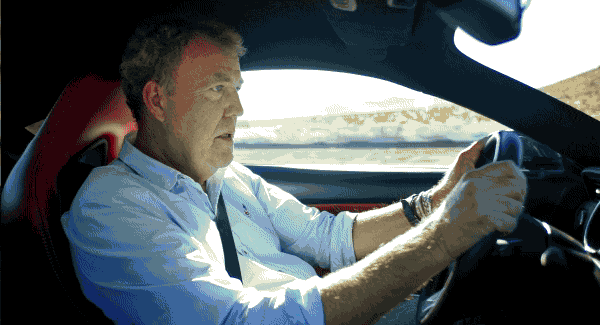
Look at how damn happy they are. Look at how happy Clarkson is.
No, seriously. Look at Clarkson again:
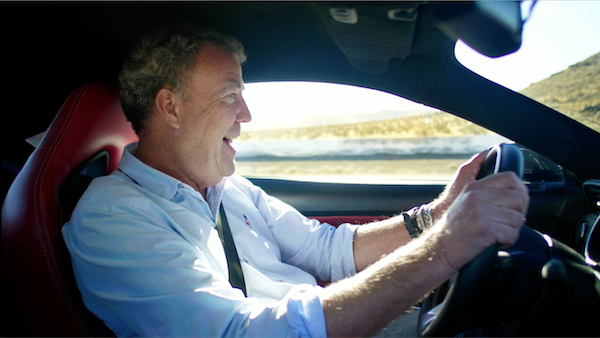
And May:
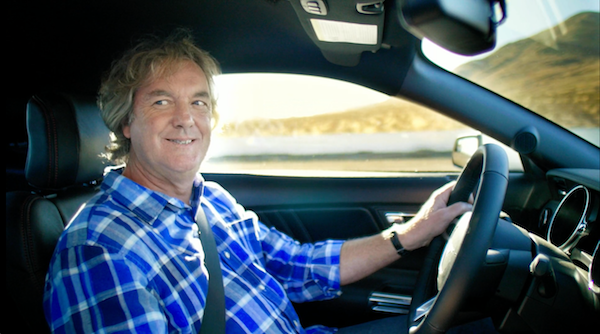
And Hammond:
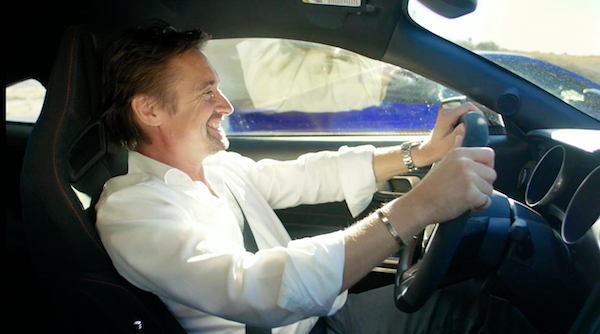
They’re back.
The opening sequence nearly brought me to tears. Truly. It’s absurd, but it’s true.
The Grand Tour opens with Clarkson making a walk of shame out of the BBC headquarters in dreary London. The musical accompanyment begins as simply a piano, forlorn, lovely, understated. We follow Clarkson to Heathrow, boarding a flight to Los Angeles. He picks up his rental car, a blue bespoke Mustang, in a parking garage. Leaving LAX, on a bright and sun-shiny day, the vocals in the background accompaniment start:
I can see clearly now; the rain is gone. I can see all the obstacles in my way…
On the road is when we see the scene above. Clarkson is met by his co-hosts, in matching red, white, and blue Mustangs. Mustangs that, like the wild animals they’re named after, are running free.
Driving in the desert, at speed, amongst a flotilla of cars of all shapes and sizes, our three heroes arrive at what appears to be a music festival—Burning Van—in the middle of nowhere. Suddenly, the question begins to make sense.
As the once-mellow opening song reaches a crescendo, our hosts emerge from their cars amongst a horde of screaming fans. It is somewhat self-indulgent, only getting worse as eight screaming jets do a low-altitude fly by over the crowd. And yet, it’s so… them. I can’t help myself smiling even larger.
The first real words of the show aren’t uttered until our boys arrive on stage, and begin to introduce each other. The hosts introduce each other one by one, mostly “taking the mickey” out of each other in the process.
The opener was perfect.
I have some problems with the first episode. Aside from the opener being a bit over the top, I felt like the segments in the tent needed work. The hosts, to my eye, looked visibly nervous. Some of the jokes, such as the Air Force and celebrity guests, fell very flat, and went on far too long.
By and large, though, I thought this first episode of The Grand Tour was great. It focused largely on cars, which is something Top Gear got dinged for forgetting to do toward the end of its run.
The title of the episode (we’re doing episode titles now, apparently) is reference to the boys finally getting to test “the holy trinity” together. We have seen the 918, P1, and The Ferrari pit against each other. Finally. Having the BMW M2 as the introduction to the “Eboladrome” didn’t hurt this BMW owner’s feelings either.
Top Gear The boys are back, and I’m so excited to see what comes next.
We’re in November, which means it’s time to start stressing thinking about holiday gifts.
As with last year, here’s some things I like that are at various price points. You may find someone in your life that may enjoy one or more of these.
As a gift to me, links here are affiliate links where possible. Some of the below I did not pay for, but can say with an honest heart I absolutely would, had I not gotten the item for free.
Under $10
Apple has discounted USB-C peripherals until the end of the year. Though you may not know anyone getting a shiny new MacBook Pro, it’s likely someone you know will eventually be getting one. For those, they may like a USB-C → USB Adapter.
Or, perhaps, you may wish to pick up a Lightning to Headphone Jack Adapter. Surely you can’t have too many of these lying around.
Under $20
Most of us need a little extra juice for our phones or tablets at some time or another. I recently picked up an Aukey battery pack that has a neat trick up its sleeve: you charge the battery via a standard Lightning port. That means the same cord that you can use to go from the battery → iPhone can also be used to go from a USB charger → the Aukey battery pack. Super convenient.
Also in this price range is one of my favorite fast casual board games. Forbidden Island is a super fun game for 2-4 players that can be played in around half an hour. It’s cooperative, so all the players either fail or they win, but they do so together. It’s easy to learn, super fun, and as challenging as you want it to be.
Under $30
I’ve nearly ruined my wife’s computer (twice) by spilling water on it while recording a podcast. A dear friend took it upon himself to get me a Mighty Mug to use to hold water while I record. I’m deeply indebted to him, as he’s surely saved many pieces of electronics from my clumsiness.
Since that gift, Mighty Mug has expanded their line, and my actual recommendation is for their Double Old Fashioned cups. These are the perfect size for a vodka on the rocks, as I like, or the liquid from a wrung out bar rag, if that’s your thing. These cups are very hard to tip over, which is doubly useful once you’ve drained them once or twice.
Under $40
Another board game, Ticket to Ride is a second favorite of mine. It is reasonably easy to explain, reasonably fast, and very fun. Unlike Forbidden Island it is competitive, but unlike more traditional games like Monopoly, it’s not easy to actively mess with your opponents. Thus, Ticket to Ride is competitive without being aggressive.
Under $50
My friends at Studio Neat have been working on a product for what feels like forever now. They sent me a very early test model a long time ago, and I love this thing. It’s finally for sale now.
The Canopy is a fancy carrying case for the Magic Keyboard (more on that below). I like taking my iMac’s Keyboard with me when I travel for more than a day or two with only my iPad Mini. It allows me to quickly fire off emails, write blog posts, or otherwise get things done. The Canopy is the perfect carrying case for the Magic Keyboard. It’s simple, pretty, and light.
NOTE: Holiday shipping for the Canopy isn’t guaranteed.
Under $75
Speaking of Studio Neat, their Material Dock is really lovely. It’s a charging stand for your iPhone and, if you have one, your Apple Watch as well. I was given a iPhone & Watch Material Dock for testing, and I immediately fell in love. The Material Dock is made of solid walnut, and some really lovely cork backing for your devices.
Note that the Material Dock requires but does not include Apple cables, so you may wish to include one of those those as well.
Under $100
As previously mentioned, I love the Apple Magic Keyboard. This keyboard is my favorite keyboard that I’ve ever used. The key travel and responsiveness are exactly what I want, and I genuinely smile at least once a day because of this keyboard.
Since it’s Bluetooth, it works with not only Macs, but also iOS devices, and presumably PCs as well. Like the Aukey battery, it charges via Lightning, which you only need to do once every couple months.
Under $200
I was recently given a set of Aftershokz Trekz Titanium bone conduction headphones. While not terribly great for music—they’re quite tinny—they are perfect for podcasts. The Trekz are also sweat/dust resistant, and fit snugly on the head, so they’re great for working out, or just being mobile doing chores. Plus, they’re Bluetooth, so there’s no wires to worry about.
Because they work via bone conduction, that leaves your ears open to be able to hear the noises around you. I love using these headphones when I’m on a walk with Declan, or like this very moment, when he’s sleeping, and I need to be able to hear the baby monitor. Very neat stuff.
Today, you turn two.
Sometime in the last six or so months, I feel like you’ve changed. You’re no longer our baby. You’re our child. I look at you and see a small boy, rather than an infant.
I’m wholly unprepared for this.
You’re talking now. Sometimes I can understand. Sometimes I need your mother to translate. Sometimes we’re both completely flummoxed. To be able to really communicate with you—to have even a tiny inkling of what’s going on in your head—changes everything.
It’s fascinating to see the world through your eyes. To see you react to things you’ve never seen. To try things you’ve never tried. To learn to cope with feelings you don’t quite understand.
Sometimes you’re frustrating. I’m told I can be, as well, from time to time.
Days like today, and most days, really, you remind me how lucky we are to have you in our lives. How lucky we are that, somehow, by some miracle, you arrived in our family.
I look back on the journey we took before you arrived, and I remember it like it was yesterday. I remember asking when our infant became a baby; how our baby could already be one. Were you born yesterday, or was it two years ago?
The days can be long. The years are always short.
I’m already looking forward to the next one. And every one I’m lucky enough to share with you after.
Happy birthday, Declan! I love you.
-Dad
This week I joined Katie Floyd and David Sparks on their long-running and excellent show, Mac Power Users. I was a previous guest a couple years ago, just before Declan was born. Now, two years later, it was a blast to come back and talk with Katie and David again.
On this episode, we discussed my transition to iOS development, some parenting tools, my Mac and iOS workflows, and how I use my Synology NAS.
Mac Power Users is a juggernaut in the Apple podcasting community. It’s an honor to be asked to participate, and always a blast to record with David and Katie.
My buddy Greg Koenig just wrote an interesting post that refutes what many people are taking as fact: Apple is producing a ceramic iPhone.
This all stemmed from a controverial post on Quora which stated, right up front:
Apple will create an iPhone primarily from ZrO2 - Zirconian Ceramics
Greg manufactures things for a living; I use his Luma Loop camera strap every time I pick up my big camera. He tends to know what he’s talking about, and uses much of the same equipment that Jony Ive does. Greg writes:
Apple is a hardware company and machined aluminum is their primary platform. At peak production, Apple is manufacturing roughly 1 million iPhones per day.
For Apple to bring a whole new long-cycle-time process online for the next iPhone, […] they would need warehouses with thousands of machines already in situ, with thousands more in production.
Greg’s post is a fascinating read, which spells out several reasons why it’s highly unlikely Apple will be releasing a ceramic iPhone anytime soon.
A couple of weeks ago I joined my buddy Jelly (of GIFWrapped fame) on his podcast about mobile app development, Mobile Couch. Since Jelly’s normal co-host—and other friend of mine—Ben was on assignment, I got to fill in.
On this episode, Jelly and I discussed both migrations from Objective-C to Swift, as well as my new forays into functional reactive programming using RxSwift.
It’s really hard to verbally describe the magic that is Rx, but I had a lot of fun recording this episode. Come for the nerd talk; stay for Jelly’s delightful accent.
This week I had my annual appointment at my optometrist. I needed to get fitted for new RGP contacts due to my Keratoconus. During my visit, he placed drops in my eyes to help his examination.
These drops rendered me farsighted for a couple hours. Crisp details were hard to make out up close. I immediately noticed this the moment I tried to use my iPhone. I couldn’t read anything on it.
I didn’t fret. I know that Apple has built a plethora of accessibility tools
into iOS. I began by taking a page out of my parents’ playbook, and increasing
the size of text on the screen. To do so, I went to
Settings → General → Accessibilty → Larger Text
and slid the slider as
far as it would go. Thankfully I knew approximately where all of these items
were, as it was very hard to read them. Cranking the text size way up made
things better:
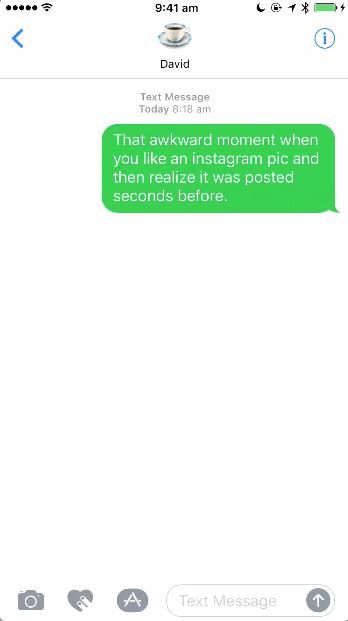
However, this wasn’t really enough. When I recorded the video above, with full
visual acuity, I could read the Larger Accessibility Sizes switch. For demo
purposes, I turned it on in the video above to show the difference.
At the time, not remembering nor being able to see the larger sizes option, I
wasn’t able to use it. I was able to just barely make out the word Zoom
in the Accessibility screen. Once I looked at the Zoom details, I was vaguely
able to see something about three fingers in the text below the switch. I
turned it on, and immediately the display zoomed in.
Intuitively, double-tapping with three fingers zoomed back out. Now that I knew how to turn it on and off, I could zoom in to read the full instructions. By dragging with three fingers, I could pan around while remaining zoomed. This was the piece I needed.
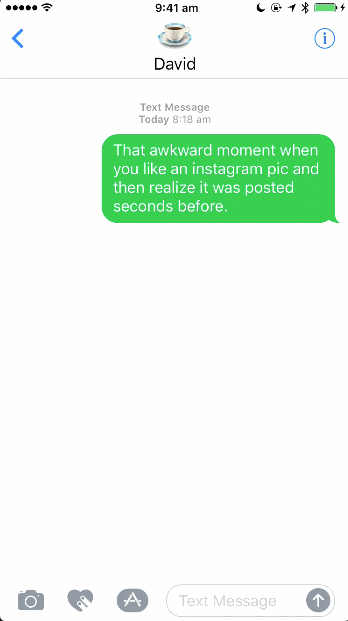
In the span of a couple minutes, without instruction, I went from being unable to see anything on my phone to being able to operate it nearly as efficiently as when I’m able to see just fine. Despite diving into these features quite literally blind with poor vision and no prior experience.
Some have been writing about accessibility—particularly for the visually impaired—for years. Until I found myself in a similar (though temporary) predicament, I didn’t realize nor appreciate how much work Apple puts into making our devices usable by everyone.
Today I joined Katie Floyd, Dan Moren, and Jason Snell on this week’s Clockwise. As usual, the four hosts discussed four topics in thirty minutes.
This week, we discussed new features in macOS Sierra, what we still long for from our phones, what we nevertheless appreciate about our phones, and Google Allo.
Clockwise is so much fun to guest on. If you haven’t listened, you should give it a shot.
The Grand Tour, spiritual successor to the BBC Top Gear that we knew and loved, has set a release date of Friday, 18 November:
The show is filming in different locations across the globe; they film in California the weekend of 24-25 September. I was actually interviewed via phone to potentially win tickets to the show, but more on that later.
The show will be broadcast on Fridays on Amazon Prime. Unlike most other online-only shows, particularly popular Netflix shows like House of Cards and Orange is the New Black, The Grand Tour will not be released in one large chunk. One episode per week, for a few weeks.
We’ve also found out a little bit more about The Grand Tour. According to Jalopnik, there’s a plethora of things that can’t be said or done on the new show:
- No Stig
- No handwritten leaderboard
- No test track
- No saying landscapes are beautiful
- Possibly no use of the word “🐔” by James
On the plus side, according to series producer Andy Wilman in the video Jalopnik discovered:
- The Grand Tour will be filmed in 4K
- There will be twelve episodes “per year”; not sure if that’s per season or per annual year. I’d guess the latter, which means 6 episodes per season.
- The contract is presently 3 years, so that means 36 new shows (!)
About that interview.
On Friday, 2 September, I received the following email:

It asked me to provide contact information so that someone from the Applause Store
(which also handled tickets for Top Gear) could
call me ring me up and talk.
On the following Monday, which was Labor Day, I received a call from Unknown.
That call was from a very lovely British lady; it lasted six minutes.
I was asked a variety of questions. Some made sense, others were odd. The ones I remember:
- Would you consider yourself a big fan of Top Gear?
- What do you like most about it?
- Have you seen the new Top Gear, with the new cast?
- Have you ever been to a car show?
- Have you ever been to a music festival? (ಠ_ಠ)
- I see you’re in Virginia. Could you be in southern California the weekend of 24-25 September, on two weeks notice?
- Who would you bring with you? (I suspect this was to ensure gender parity)
- What’s your favorite car?
I gave the best answers I could. I did make mention of Top Gear Party, but neglected to mention my vanity license plate is inspired by one of the members of the show. I did my best to sell myself, without being too over the top.
I never heard back from the Applause Store, so it sounds like I won’t be making an emergency trip to Southern California.
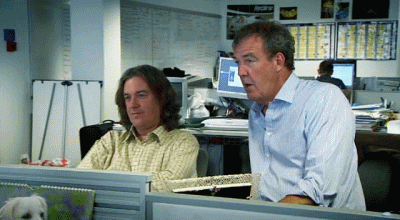
You can’t win 'em all.
Nonetheless, I am super pumped for November.
I just ordered a new iPhone, last night this morning, at 3:11 AM. I got an iPhone 7, [matte] Black, 128 GB. It should ship on launch day.
In placing the order, I learned several things, which I’m putting here mostly to help me remember next year.
The day before
Apple shuts the store down the afternoon/evening of the day before preorders begin, so it’s important to get these steps done ahead of time.
- It’s best to use the
Apple Storeapp to place your order, on the device that you will be replacing. It’s a bit cruel to use your current device to order its replacement, but it’s fastest. Using the web is almost always a recipe for misery. - If at all possible, set up Apple Pay on that device.
- Confirm your default shipping and payment information:
Apple Storeapp:Accounttab →Primary PaymentandPrimary Shipping- Apple Pay:
Settingsapp →Wallet & Apple Pay→Shipping Address
- Speaking of shipping address:
- If possible, choose your place of business. The delivery will require a signature, and you don’t want to be trapped at home all day.
- That said, AT&T requires you to ship new devices to the address they have on file. Good luck if you’re on a multi-city family plan.
- Back in the
Apple Storeapp, find the device you want, and configure it (go through all the motions like you’re going to buy it right now), and save it as a favorite. - Also make sure you’ve enabled the
Apple Storeapp keeping you logged in, as well as your carrier settings. There’s one switch to flip for both:
Accounttab →Account Settings→Remember Me
The night of
Please note that things won’t be exactly the same for those upgrading via the iPhone Update Program, as of the iPhone 7 you must make an in-store appointment to surrender your 6S, and collect your 7. I’ve also heard second-hand reports that availability was extremely limited for upgraders. Your mileage may vary.
- Wake up a few minutes before preorders go on sale. They are supposed to start at midnight Pacific time, but in reality it’s often 5-10 minutes later. I set my alarm at 2:58 AM for a (roughly) 3 AM sale time.
- Use your cellular connection when you wait for the Apple Store to come back online. I found my otherwise-fantastic FiOS connection didn’t see the store come back up as quickly.
- Though the Apple Store app does (sometimes) refresh itself when you simply leave it and return to it, I’d recommend force-quitting it, reopening it, repeat. That forces the app to refresh and see if the store is up or not.
- When the store comes back up, go to
Accounttab →My Favoritesand proceed from the favorite you saved earlier. It’ll save you time. - When you check out, pay with Apple Pay. It’s faster and increases your chances
of getting your order through quickly.
- Be careful, though, that the correct addresses and e-mails are used.
I found that an old, busted, e-mail address was somehow used for my order,
despite me having confirmed my settings in the
Apple Storeapp ahead of time.
- Be careful, though, that the correct addresses and e-mails are used.
I found that an old, busted, e-mail address was somehow used for my order,
despite me having confirmed my settings in the
- For Americans, on the iPhone 7 anyway, if you’d like to get an unlocked, SIM-free
phone, your only choice is T-Mobile. Unlike all the other carriers, they do
not ask for any sort of account confirmation during the order process.
- However, in the case of the iPhone 7 anyway, those phones do not support CDMA carriers Sprint and Verizon.
The wait
I cannot recommend Deliveries enough to track your order. They have apps for all the Apple platforms, and they’re all great. Deliveries supports tracking by Apple order number.
Additionally, often times a day or two before your target delivery date, you can actually get your tracking information before Apple sends it to you. It changes often whether Apple uses FedEx or UPS to ship the phones, but either way, go to the tracking page for either carrier.
Tracking by reference
Once you’re on the tracking page, try to track a package by reference. Try using either your billing phone number or your iPhone’s phone number as that reference number. (I’ve seen both used in the past). Sometimes, this will give you your iPhone tracking information. Sometimes, it doesn’t. Can’t hurt to try.
In the case of UPS, which Apple has used for me in recent years, it’s worth
noting that you must be on the desktop site to track by reference.
Additionally, you may find that you can also use your Apple order number,
with the last two characters truncated, as a reference number. For example,
for order W123456789, try to track by reference W1234567.
UPS My Choice
For the iPhone 7, I signed into my free UPS My Choice account in order to see if the tracking number was visible. When I went to my Delivery Planner calendar, I noticed on Wednesday (the first time I looked) that my phone had a tracking number and was scheduled for Friday.
Arrival day
It’s worth noting that in years past, if you’d like, Apple has allowed you to print and pre-sign a form and tape it to your door. You can print the signature form PDF from your order status page. The delivery person is supposed to take that as proof of signature, and leave you your phone. Depending on the area in which you live, this may be risky, as the iPhones ship in boxes that look like they have iPhones in them.
- Upgrade your existing phone to the latest version of iOS—in this case, iOS 10—before you do anything. Since the iPhone 7 will presumably ship with 10, it’ll make the whole backup dance much easier.
- Unpair your Apple Watch, if you have one, from your iPhone
Additionally, if you have an Apple Watch with LTE, unless you’re switching carriers, choose to keep your service. More in this kbase article. - Perform a backup of your iPhone, preferably to iTunes, preferably with
Encrypt iPhone backupchecked, so that your passwords will restore automatically on the new phone - Go through the onboarding on the new iPhone
- Restore the backup you created in step #2
- Re-pair your Apple Watch with your new iPhone.
Here’s hoping your purchase experience—and mine!—is as smooth as possible in 2017.
UPDATED 10 September 2016 2:00 PM: Added some thoughts about the iPhone Upgrade Program, updating your existing phone, and pre-signing for delivery.
UPDATED 13 September 2016 07:45 AM: Added information about using UPS My Choice to get your tracking number.
UPDATED 1 November 2017 11:00 PM: Added information about Apple Watch with LTE, and tracking by reference.